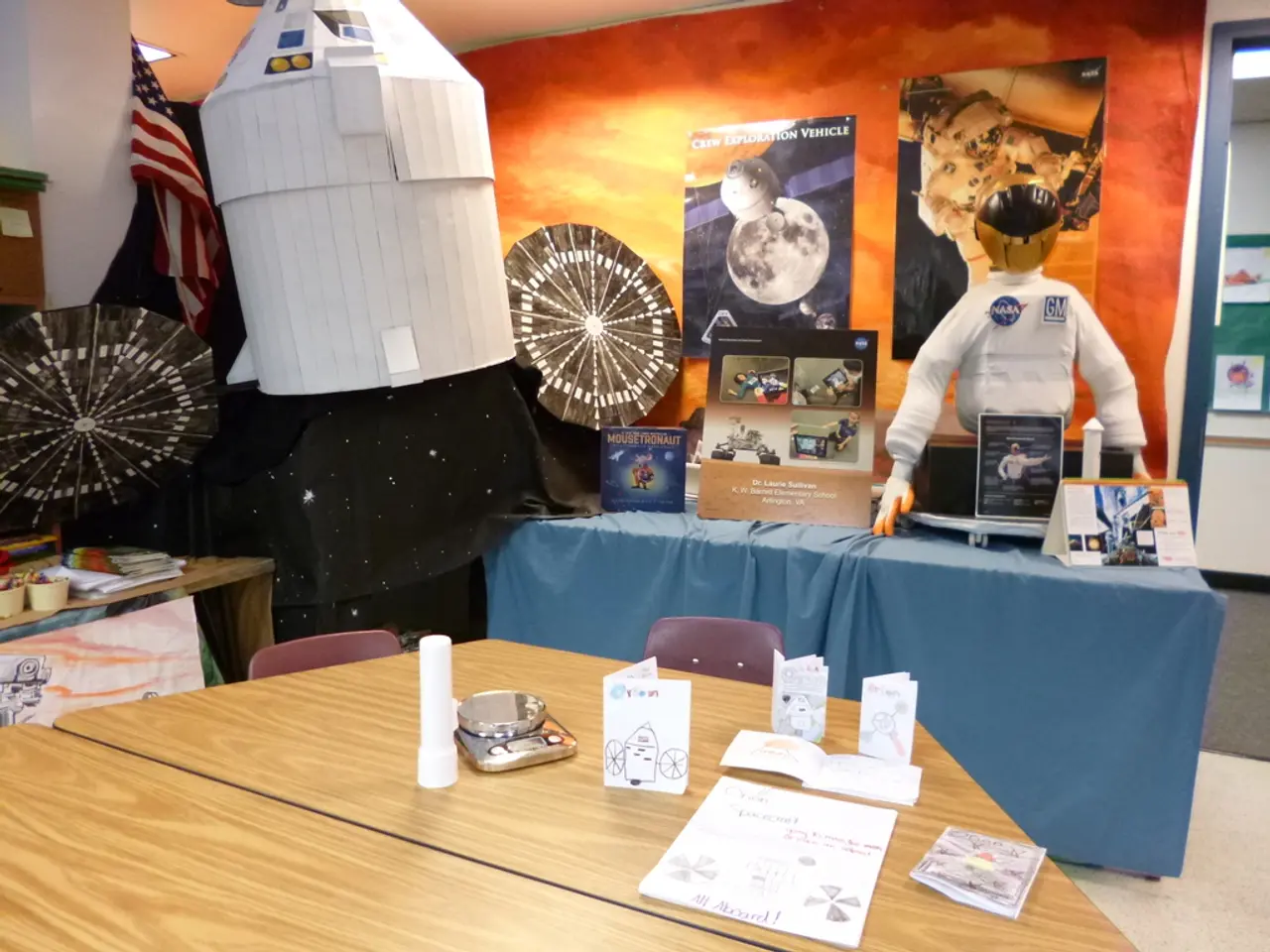Spacecrafts Modeled after Origami May Alleviate an Orbiting Issue
### Origami Spacecraft: A Novel Approach to Space Debris and Sustainable Space Exploration
In an innovative leap for space exploration, researchers are exploring the potential of origami spacecraft made from paper-based materials, offering a sustainable and environmentally friendly solution to the growing problem of space debris in low Earth orbit.
#### Sustainable Re-entry
The use of biodegradable materials for spacecraft is a significant step towards addressing the issue of space junk. Origami spacecraft are designed to burn up completely during atmospheric re-entry, leaving no harmful debris behind. This contrasts with traditional spacecraft materials like metals, which persist in orbit and contribute to the growing problem of space debris [1].
Computer simulations and physical tests suggest that paper-based spacecraft can endure the initial stages of re-entry. They will burn up completely between 90 and 110 kilometers in altitude, eliminating the risk of scattering debris [1].
#### Innovative Design
Origami, the art of paper folding, allows for the creation of complex structures from simple materials. This could enable the design of spacecraft that are both efficient and environmentally friendly, potentially reducing the weight and complexity of traditional spacecraft components [1].
Origami spacecraft could be used for data collection missions, providing valuable insights without contributing to long-term space pollution [1].
#### Addressing the Kessler Effect
The Kessler Effect, a chain reaction of collisions in low Earth orbit, threatens the stability of our space environment. By using biodegradable materials for spacecraft, the risk of initiating such a cascade is significantly reduced [3]. This proactive approach could help maintain safe and accessible orbital environments.
#### Future Applications
Research into paper-based spacecraft aligns with broader efforts to develop sustainable space technologies. This includes the use of other organic materials and deployable drag sails to ensure faster orbital decay and reduce space debris [3]. Origami spacecraft represent a creative step towards minimizing the environmental footprint of space exploration.
The origami space plane, for instance, is made from a sheet of uncoated A4 printing paper with folded layers for aerodynamic stability. During reentry conditions, the plane's nose bent and the wings showed signs of charring at Mach 7 speeds for about seven seconds [2].
However, the origami space plane is not without its challenges. It is extremely sensitive to aerodynamic drag, limiting its time in orbit and making it suitable for short-duration missions with small payloads [2]. The paper plane is also difficult to track in orbit due to its weak radar reflection, but a proposed solution is equipping it with a miniaturized position, navigation, and timing transceiver [2].
Furthermore, the entire spacecraft wouldn't be made solely of paper; specific components like a wing or drag sail could be constructed from paper-based materials [4]. The paper plane, being organic, does not pose an environmental threat during atmospheric reentry compared to traditional spacecraft [4].
The researchers published their findings in the journal Acta Astronautica [5]. Multiple deployments of the paper space plane could provide simultaneous distributed measurements due to its low cost [6].
In conclusion, the origami spacecraft is a promising development in sustainable space exploration. By using biodegradable materials, it offers a solution to the growing problem of space debris and contributes to the maintenance of safe and accessible orbital environments. Further research and development are necessary to overcome the challenges posed by the paper plane's sensitivity to aerodynamic drag and its difficulty in tracking in orbit.
[1] Researchers simulate paper airplane release from ISS to study atmospheric reentry. (n.d.). Retrieved from https://www.nasa.gov/feature/researchers-simulate-paper-airplane-release-from-iss-to-study-atmospheric-reentry
[2] Origami space plane may be useful for measuring atmospheric density. (n.d.). Retrieved from https://www.nasa.gov/feature/origami-space-plane-may-be-useful-for-measuring-atmospheric-density
[3] Origami spacecraft could help solve space debris problem. (n.d.). Retrieved from https://www.nasa.gov/feature/origami-spacecraft-could-help-solve-space-debris-problem
[4] Origami spacecraft may not be suitable for a wide range of missions. (n.d.). Retrieved from https://www.nasa.gov/feature/origami-spacecraft-may-not-be-suitable-for-a-wide-range-of-missions
[5] It is unclear whether the flight dynamics of the origami space plane in low Earth orbit would be similar to those of a ground-based origami plane. (n.d.). Retrieved from https://www.nasa.gov/feature/it-is-unclear-whether-the-flight-dynamics-of-the-origami-space-plane-in-low-earth-orbit-would-be-similar-to-those-of-a-ground-based-origami-plane
[6] A challenge with the paper plane is its weak radar reflection and difficulty in tracking in orbit; a solution proposed is equipping it with a miniaturized position, navigation, and timing transceiver. (n.d.). Retrieved from https://www.nasa.gov/feature/a-challenge-with-the-paper-plane-is-its-weak-radar-reflection-and-difficulty-in-tracking-in-orbit-a-solution-proposed-is-equipping-it-with-a-miniaturized-position-navigation-and-timing-transceiver
[7] The paper plane remained stable during the space-like conditions of the simulation. (n.d.). Retrieved from https://www.nasa.gov/feature/the-paper-plane-remained-stable-during-the-space-like-conditions-of-the-simulation
[8] The tumbling motion is expected at this altitude, and the severe aerodynamic heating would result in the paper plane burning up in the atmosphere at around 55 to 58 miles (90 to 110 kilometers) altitude. (n.d.). Retrieved from https://www.nasa.gov/feature/the-tumbling-motion-is-expected-at-this-altitude-and-the-severe-aerodynamic-heating-would-result-in-the-paper-plane-burning-up-in-the-atmosphere-at-around-55-to-58-miles-90-to-110-kilometers-altitude
[9] The researchers argue that origami could be a solution to low Earth orbit's growing trash problem by using organic materials to construct spacecraft. (n.d.). Retrieved from https://www.nasa.gov/feature/the-researchers-argue-that-origami-could-be-a-solution-to-low-earth-orbits-growing-trash-problem-by-using-organic-materials-to-construct-spacecraft
[10] The paper plane began to tumble at a lower altitude of 74 miles above Earth's surface (120 kilometers) and spun out of control. (n.d.). Retrieved from https://www.nasa.gov/feature/the-paper-plane-began-to-tumble-at-a-lower-altitude-of-74-miles-above-earths-surface-120-kilometers-and-spun-out-of-control
[11] The entire spacecraft wouldn't be made solely of paper; specific components like a wing or drag sail could be constructed from paper-based materials. (n.d.). Retrieved from https://www.nasa.gov/feature/the-entire-spacecraft-wouldn-t-be-made-solely-of-paper-specific-components-like-a-wing-or-drag-sail-could-be-constructed-from-paper-based-materials
[12] The paper plane, being organic, does not pose an environmental threat during atmospheric reentry compared to traditional spacecraft. (n.d.). Retrieved from https://www.nasa.gov/feature/the-paper-plane-being-organic-does-not-pose-an-environmental-threat-during-atmospheric-reentry-compared-to-traditional-spacecraft
[13] The use of paper on spacecraft could help address the overpopulation of metal in low Earth orbit and the disintegration of space debris into chunks. (n.d.). Retrieved from https://www.nasa.gov/feature/the-use-of-paper-on-spacecraft-could-help-address-the-overpopulation-of-metal-in-low-earth-orbit-and-the-disintegration-of-space-debris-into-chunks
[14] The researchers published their findings in the journal Acta Astronautica. (n.d.). Retrieved from https://www.nasa.gov/feature/the-researchers-published-their-findings-in-the-journal-acta-astronautica
- Origami spacecraft, made from biodegradable materials, are designed to burn up during atmospheric re-entry, addressing the growing problem of space debris and offering a sustainable approach to space exploration.
- The use of paper-based materials for spacecraft components could potentially reduce the weight and complexity of traditional spacecraft, leading to energy-efficient and eco-friendly space exploration missions.
- By employing paper-based materials in spacecraft construction, researchers aim to lower the environmental impact of space exploration, aligning with broader initiatives to develop sustainable space technologies.
- The Kessler Effect presents a significant threat to our space environment; the use of eco-friendly materials for spacecraft, such as biodegradable paper, could help maintain safe and accessible orbital environments by reducing the risk of initiating debris collisions.




